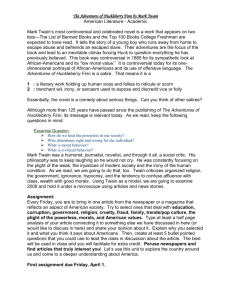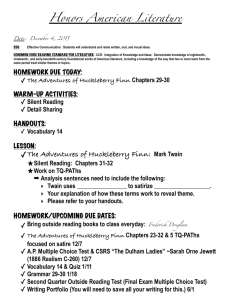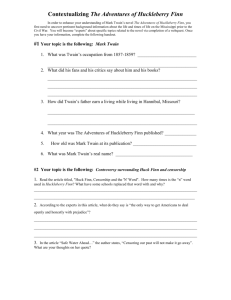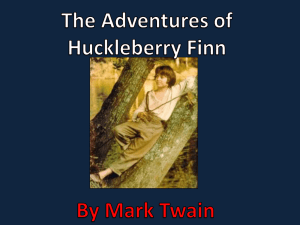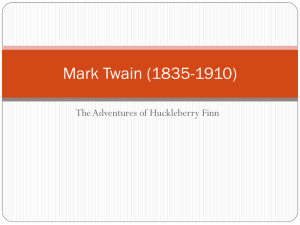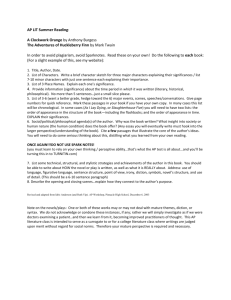4-23-10 Huck Finn setting and themes
advertisement
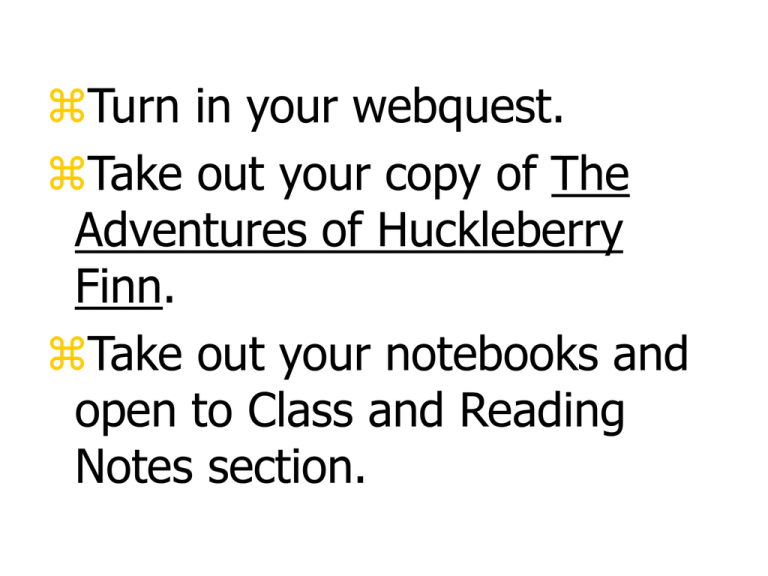
Turn in your webquest. Take out your copy of The Adventures of Huckleberry Finn. Take out your notebooks and open to Class and Reading Notes section. The Adventures of Huckleberry Finn *See the Reading and Assignment Timeline The final Socratic seminar will focus on analysis of Twain’s works according to these Language Arts Standards: 1. READING 3.2 - Analyze the way in which the theme or meaning of a selection represents a view or comment on life, using textual evidence to support the claim. What larger ideas, themes, and social commentary/criticisms are presented? In what ways did Twain use SATIRE and what social comments and criticisms are being made? 2. 3. READING 3.3 - Analyze the ways in which irony, tone, mood, the author’s style, and the “sound” of language are used to achieve specific purposes or effects. What examples of conscious and unconscious irony do you find? What kind of a mood and tone does Twain set? How does the language style and sound of the language Twain uses contribute to the story? READING 3.7 c. - Evaluate the philosophical, political, religious, ethical, and social influences of the historical period that shaped the characters, plots, and settings. What specific political, religious, ethical and social influences of this pre-Civil- War time period influenced Twain and his writings? CHARACTER LOG (50 points) KEEP TRACK OF CHARACTERS AS THEY APPEAR. MAKE A CHART THAT LISTS FOR EACH CHARACTER: CHARACTER NAME CHAPTER HE/SHE FIRST APPEARS BRIEF DESCRIPTION AND IMPORTANT ACTIONS Setting Remember: Setting in a literary work is the time, place and situation in which the action occurs. Setting includes geographic location, historical period, time of day or year, and customs and manners of the society. Setting (continued) Twain deliberately set The Adventures of Huckleberry Finn in the American South before the Civil War. Using this setting, Twain was able to evoke an era of bitter turmoil--some states embraced slavery, others condemned it. Twain used this setting for dramatic purpose. If Jim could just make it to the Ohio River, he could travel to the states in which he would be free. Setting (continued) Mississippi River - This setting was no accident. Twain’s fondest memories centered on his time as a riverboat pilot. He knew the river--He knew its positive attractions for people, its dangers, and he knew the people who lived near it and made a living from it. Twain’s familiarity with the Mississippi gives HF much of its authenticity. Jim and freedom Jim’s plan is to reach the Illinois town of Cairo, and from there, he can take the Ohio River up to the free states. Original 1857 Map of the United States Showing the Free and Slave States Dark green = free states Light green = Free “territories" which were not yet states. Red (dark pink) = Slave importing states Pink = Slave states that exported slaves Theme Society’s values and laws can be in conflict with individual moral values. Theme People tend to behave differently, irrationally, or even cruelly, in large groups. Theme Gullible people are responsible for their own deception. Theme Greed can destroy lives. Theme Freedom means different things to different people. Theme “Freedom” vs. “conformity” Discussion Question What IS “freedom?” What is “conformity?” What do we gain/give up when we “conform?” Discussion Question: What elements of the story do you find unrealistic or incongruous to what actions real people in these situations might take? CHARACTERS – Chapter 1 Huck Finn (Aunt Polly) (Mary) Tom Sawyer Judge Thatcher Widow Douglas Miss Watson AUDIO BOOK OF HUCK FINN http://www.loudlit.org/works/hfinn.htm
